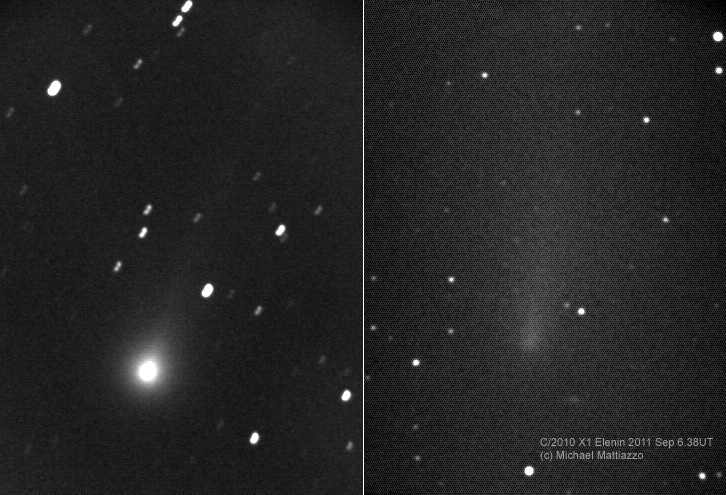Comet Elenin Could Be Falling Apart, Skywatcher's Photos Suggest

The icy comet Elenin made its closest pass by the sun this month, but it may have come out of the event worse for wear, according to an Australian astronomer.
Images and video of comet Elenin recorded by amateur astronomer Michael Mattiazzo in Castlemaine, Australia, appears to show the object losing some cohesion in late August and early September as it neared its closest approach to the sun — a point in its orbit called "perihelion," — on Sept. 10.
The comet is officially known as C/2010 X1 Elenin, and was discovered in December by Russian astronomer Leonid Elenin. [See Mattiazzo's photo and video of comet Elenin]
"I had suspicions about this comet since discovery in December 2010 that it would not survive its perihelion passage," Mattiazzo told SPACE.com in an email. "C/2010 X1 Elenin is an intrinsically faint (small) comet making its first passage through the inner solar system. These 'non-periodic' comets tend to perform below expectations as opposed to reliable and predictable periodic comets such as 1P Halley."
The famed comet Halley, better known as Halley's Comet, makes a pass through the inner solar system once every 76 years.
NASA officials at the Jet Propulsion Laboratory in Pasadena, Calif., told SPACE.com that the space agency is waiting for Elenin to re-emerge from its perihelion pass near the sun before making new observations. The space agency's Solar and Heliospheric Observatory (SOHO) may be able to observe the comet between Sept. 23 and 29.
Comet Elenin is expected to pass nearest to Earth on Oct. 16, when it will be about 22 million miles (35 million kilometers) from our planet. The comet is between 2 and 3 miles (3 to 5 kilometers) wide.
Get the Space.com Newsletter
Breaking space news, the latest updates on rocket launches, skywatching events and more!
Mattiazzo said that he is no stranger to seeing comets fizzle as they near the sun.
"I witnessed the spectacular demise of C/1999 S4 LINEAR in July 2000, when it appeared as an elongated cigar shaped smudge through binoculars," Mattiazzo said. "This time around, C/2010 X1 Elenin is more difficult to observe since it is located very low in the western evening sky and only then, observable from the Southern Hemisphere. Let's hope that northerners have something to see by the time it reappears in October morning skies. Perhaps a very faint, long, diffuse smudge."
NASA astronomers have used some space telescopes to observe comet Elenin's pass through the inner solar system. Last month, the space agency's Stereo sun-watching spacecraft spotted the icy comet.
Comet Elenin has gained an Internet following largely due to apocalyptic rumors that claim the comet will align with other planets and wreak havoc. Another doomsday scenario claims that Elenin is not a comet at all, but in fact a rogue planet called Nibiru that will also bring about the end times on Earth.
NASA has dismissed all claims that comet Elenin is anything more than just a dim comet.
"Any approximate alignments of comet Elenin with other celestial bodies are meaningless, and the comet will not encounter any dark bodies that could perturb its orbit, nor will it influence us in any way here on Earth," Don Yeomans, a scientist at JPL, said in a statement last month.
You can follow SPACE.com Managing Editor Tariq Malik on Twitter @tariqjmalik. Follow SPACE.com for the latest in space science and exploration news on Twitter @Spacedotcom and on Facebook.
Join our Space Forums to keep talking space on the latest missions, night sky and more! And if you have a news tip, correction or comment, let us know at: community@space.com.

Tariq is the Editor-in-Chief of Space.com and joined the team in 2001, first as an intern and staff writer, and later as an editor. He covers human spaceflight, exploration and space science, as well as skywatching and entertainment. He became Space.com's Managing Editor in 2009 and Editor-in-Chief in 2019. Before joining Space.com, Tariq was a staff reporter for The Los Angeles Times covering education and city beats in La Habra, Fullerton and Huntington Beach. In October 2022, Tariq received the Harry Kolcum Award for excellence in space reporting from the National Space Club Florida Committee. He is also an Eagle Scout (yes, he has the Space Exploration merit badge) and went to Space Camp four times as a kid and a fifth time as an adult. He has journalism degrees from the University of Southern California and New York University. You can find Tariq at Space.com and as the co-host to the This Week In Space podcast with space historian Rod Pyle on the TWiT network. To see his latest project, you can follow Tariq on Twitter @tariqjmalik.









